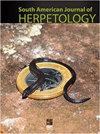Diet and Habitat Use of Proceratophrys ararype (Anura: Odontophrynidae), an Endemic Frog from the Chapada do Araripe, Northeastern Brazil
IF 0.7
4区 生物学
Q4 ZOOLOGY
引用次数: 0
Abstract
Abstract. Informa(on on the use of food resources and habitat are important tools for understanding trophic niche and ecological rela(onships. Many factors can influence the diet and ea(ng habits of anurans. Species of the genus Proceratophrys are important components of the leaf li:er frog communi(es in the Neotropical forests, including P. ararype, a species with restricted distribu(on in northeast Brazil. Therefore, we describe aspects of habitat use and evaluate the diet of P. ararype and compare these results with informa(on on other Proceratophrys species. We collected, dissected, and examined the gastrointes(nal tracts of 40 individuals, among which 55% contained food items, with 11 prey categories iden(fied. We also tested the rela(onship between prey item categories and sampling sites, differences between males and females, and the rela(onship between frog size and prey. The species can be characterized as generalist, and the volume of prey ingested was not related to the average size of the individuals. Addi(onally, the habitat most used by the anuran was leaf li:er; thus, it was inferred that this frog species uses the environment horizontally. The data found and comparisons with the literature suggest that the diet composi(on of P. ararype is determined by the availability of arthropods in the environment. This study demonstrates the importance of understanding habitat use, highligh(ng opportunis(c behavior, such as the pa:ern found for anuran amphibians, contribu(ng to elucidate the biology of anurans with relictual distribu(on, especially in semi-arid regions.巴西东北部地区特有蛙种原齿蛙(无尾目:齿蛙科)的食性和生境利用
摘要食物资源利用和生境信息是了解营养生态位和生态关系的重要工具。许多因素可以影响动物的饮食和饮食习惯。原角蛙属(Proceratophrys)是新热带森林叶蛙群落的重要组成部分,包括巴西东北部有限分布的原角蛙(P. arartype)。因此,本研究描述了原顶蕨的生境利用,评价了原顶蕨的食性,并与其他原顶蕨的食性进行了比较。我们收集、解剖和检查了40只个体的胃肠道,其中55%含有食物,确定了11种猎物类别。我们还测试了猎物种类与采样地点之间的关系,雄性和雌性之间的差异以及青蛙大小与猎物之间的关系。该物种具有多面手的特征,食用量与个体的平均体型无关。此外,阿努兰最常使用的栖息地是叶丛;因此,我们推断这种蛙是水平利用环境的。所发现的数据以及与文献的比较表明,弓形虫的饮食组成是由环境中节肢动物的可用性决定的。本研究证明了了解栖息地利用的重要性,强调了机会行为,如无尾两栖动物的栖息地,有助于阐明无尾两栖动物的生物学特征,特别是在半干旱地区。
本文章由计算机程序翻译,如有差异,请以英文原文为准。
求助全文
约1分钟内获得全文
求助全文
来源期刊
CiteScore
1.50
自引率
0.00%
发文量
10
期刊介绍:
The South American Journal of Herpetology (SAJH) is an international journal published by the Brazilian Society of Herpetology that aims to provide an effective medium of communication for the international herpetological community. SAJH publishes peer-reviewed original contributions on all subjects related to the biology of amphibians and reptiles, including descriptive, comparative, inferential, and experimental studies and taxa from anywhere in the world, as well as theoretical studies that explore principles and methods.

 求助内容:
求助内容: 应助结果提醒方式:
应助结果提醒方式:


